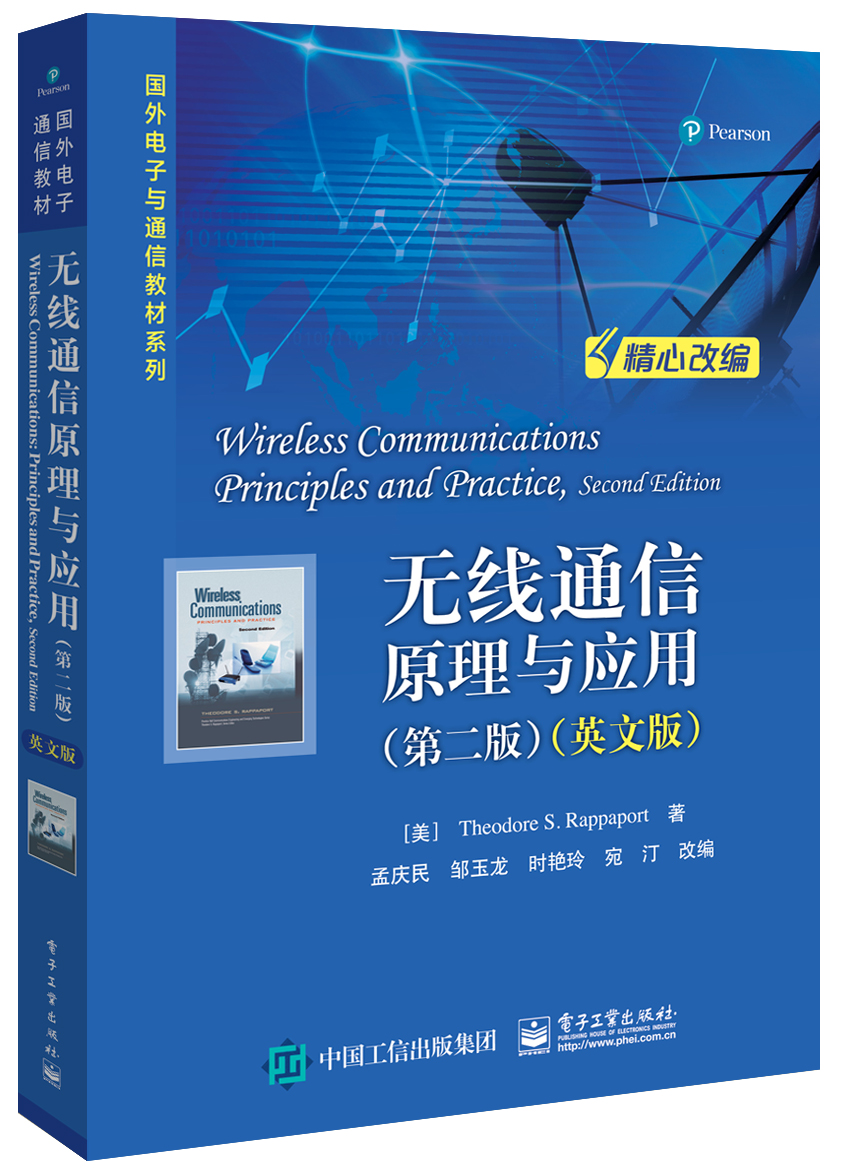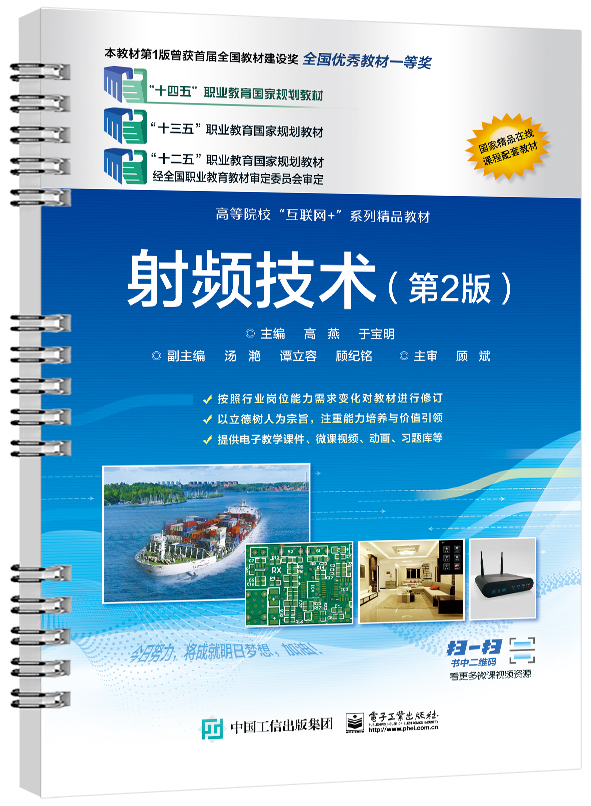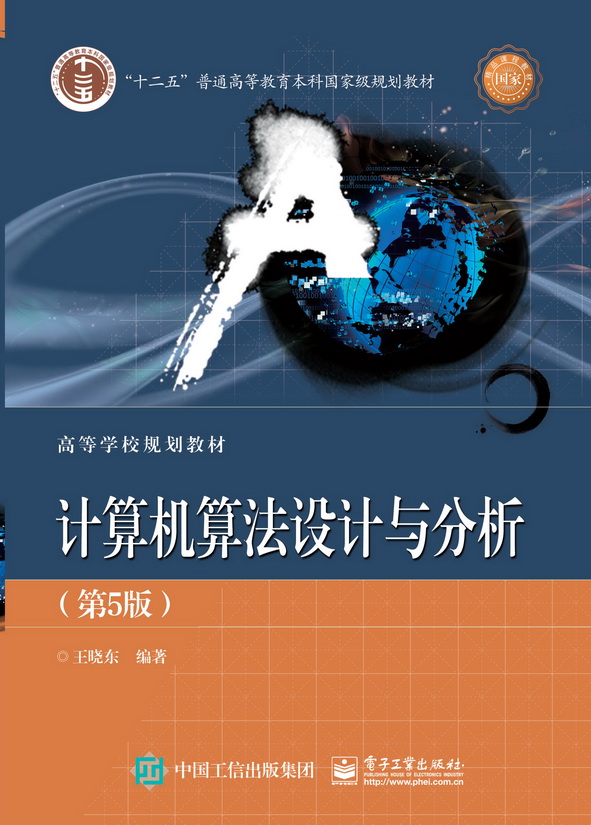无线通信原理与应用(第二版)(英文版)
丛 书 名:
国外电子与通信教材系列
作 译 者:孟庆民等
出 版 日 期:2018-01-01
书 代 号:G0334640
I S B N:9787121334641
图书简介:
本书可提供英文原版教辅(插图,习题解答),具体申请方式请联系Te_service@phei.com.cn。本书是无线通信课程的权威教材,面向那些已经熟悉诸如概率论、通信原理和基本电磁学等技术概念的学生与工程师。全书深入浅出地讨论了无线通信技术与系统设计方面的内容,包括无线网络涉及的所有基本问题,特别是3G系统和无线局域网的问题,并对无线网络技术进展和全球主要的无线通信标准给出了论述。全书共分8章,集中讲述了蜂窝的概念、移动无线电传播、调制技术、多址技术等,结合理论对无线通信系统的各个方面做了精辟论述和统计分析。
-
配 套 资 源图书特别说明:由于成本考虑,本书不作为参考书赠送。如果确有授课教材选用的需求,可将详细情况发送给本书专属联系人,我们将进一步沟通并酌情处理。
本书资源
本书暂无资源推荐资源
-
图 书 内 容
内容简介
本书可提供英文原版教辅(插图,习题解答),具体申请方式请联系Te_service@phei.com.cn。本书是无线通信课程的权威教材,面向那些已经熟悉诸如概率论、通信原理和基本电磁学等技术概念的学生与工程师。全书深入浅出地讨论了无线通信技术与系统设计方面的内容,包括无线网络涉及的所有基本问题,特别是3G系统和无线局域网的问题,并对无线网络技术进展和全球主要的无线通信标准给出了论述。全书共分8章,集中讲述了蜂窝的概念、移动无线电传播、调制技术、多址技术等,结合理论对无线通信系统的各个方面做了精辟论述和统计分析。图书详情
ISBN:9787121334641开 本:16开页 数:464字 数:965.0本书目录
Chapter 1 Introduction to Wireless Communication Systems 无线通信系统概述 1.1?Evolution of Mobile Radio Communications 移动无线通信的发展 1.2?Mobile Radiotelephony in the U.S. 美国移动无线电话 1.3?Mobile Radio Systems Around the World 全球移动通信系统 1.4?Examples of Wireless Communication Systems 无线通信系统的实例 1.4.1?Paging Systems 1.4.2?Cordless Telephone Systems 1.4.3?Cellular Telephone Systems 1.4.4 Comparison of Common Wireless Communication Systems 1.5 Trends in Cellular Radio and Personal Communications 蜂窝无线通信和个人通信的发展趋势 1.6 Problems 习题 Chapter 2 Modern Wireless Communication Systems 现代无线通信系统 2.1 Second Generation (2G) Cellular Networks 2G蜂窝网络 2.1.1 Evolution to 2.5G Mobile Radio Networks 2.1.2 Evolution for 2.5G TDMA Standards 2.1.3 IS-95B for 2.5G CDMA 2.2 Third Generation (3G) Wireless Networks 3G无线网络 2.2.1 3G W-CDMA (UMTS) 2.2.2 3G cdma2000 2.2.3 3G TD-SCDMA 2.3 Wireless Local Loop (WLL) and LMDS 无线本地环路(WLL)与LMDS 2.4 Wireless Local Area Networks (WLANs) 无线局域网(WLAN) 2.5 Bluetooth and Personal Area Networks (PANs) 蓝牙和个域网(PAN) 2.6 Summary 小结 2.7 Problems 习题 Chapter 3 The Cellular Concept—System Design Fundamentals 蜂窝的概念:系统设计基础 3.1 Introduction 概述 3.2 Frequency Reuse 频率复用 3.3 Channel Assignment Strategies 信道分配策略 3.4 Handoff Strategies 切换策略 3.4.1 Prioritizing Handoffs 3.4.2 Practical Handoff Considerations 3.5 Interference and System Capacity 干扰和系统容量 3.5.1 Co-channel Interference and System Capacity 3.5.2 Channel Planning for Wireless Systems 3.5.3 Adjacent Channel Interference 3.5.4 Power Control for Reducing Interference 3.6 Trunking and Grade of Service 中继和服务等级 3.7 Improving Coverage and Capacity in Cellular Systems 提高蜂窝系统容量 3.7.1 Cell Splitting 3.7.2 Sectoring 3.7.3 Repeaters for Range Extension 3.7.4 A Microcell Zone Concept 3.8 Summary 小结 3.9 Problems 习题 Chapter 4 Mobile Radio Propagation: Large-Scale Path Loss 移动无线电传播:大尺度路径损耗 4.1 Introduction to Radio Wave Propagation 无线电波传播介绍 4.2 Free Space Propagation Model 自由空间传播模型 4.3 Relating Power to Electric Field 电场和功率 4.4 The Three Basic Propagation Mechanisms 三种基本传播机制 4.5 Reflection 反射 4.5.1 Reflection from Dielectrics 4.5.2 Brewster Angle 4.5.3 Reflection from Perfect Conductors 4.6 Ground Reflection (Two-Ray) Model 地面反射(双线)模型 4.7 Diffraction 绕射 4.7.1 Fresnel Zone Geometry 4.7.2 Knife-edge Diffraction Model 4.7.3 Multiple Knife-edge Diffraction 4.8 Scattering 散射 4.8.1 Radar Cross Section Model 4.9 Practical Link Budget Design Using Path Loss Models 运用路径损耗模型进行实际的链路预算设计 4.9.1 Log-distance Path Loss Model 4.9.2 Log-normal Shadowing 4.9.3 Determination of Percentage of Coverage Area 4.10?Outdoor Propagation Models 室外传播模型 4.10.1 Longley–Rice Model 4.10.2 Durkin’s Model—A Case Study 4.10.3 Okumura Model 4.10.4 Hata Model 4.10.5 PCS Extension to Hata Model 4.10.6 Walfisch and Bertoni Model 4.10.7 Wideband PCS Microcell Model 4.11?Indoor Propagation Models 室内传播模型 4.11.1 Partition Losses (same floor) 4.11.2 Partition Losses between Floors 4.11.3 Log-distance Path Loss Model 4.11.4 Ericsson Multiple Breakpoint Model 4.11.5 Attenuation Factor Model 4.12?Signal Penetration into Buildings 建筑物信号穿透 4.13?Ray Tracing and Site Specific Modeling 射线跟踪和特定站址建模 4.14?Problems 习题 Chapter 5 Mobile Radio Propagation: Small-Scale Fading and Multipath 移动无线电传播:小尺度衰落和多径效应 5.1 Small-Scale Multipath Propagation 小尺度多径传播 5.1.1 Factors Influencing Small-Scale Fading 5.1.2 Doppler Shift 5.2 Impulse Response Model of a Multipath Channel 多径信道的冲激响应模型 5.2.1 Relationship Between Bandwidth and Received Power 5.3 Small-Scale Multipath Measurements 小尺度多径测量 5.3.1 Direct RF Pulse System 5.3.2 Spread Spectrum Sliding Correlator Channel Sounding 5.3.3 Frequency Domain Channel Sounding 5.4 Parameters of Mobile Multipath Channels 移动多径信道的参数 5.4.1 Time Dispersion Parameters 5.4.2 Coherence Bandwidth 5.4.3 Doppler Spread and Coherence Time 5.5 Types of Small-Scale Fading 小尺度衰落类型 5.5.1 Fading Effects Due to Multipath Time Delay Spread 5.5.2 Fading Effects Due to Doppler Spread 5.6 Rayleigh and Ricean Distributions 瑞利和莱斯分布 5.6.1 Rayleigh Fading Distribution 5.6.2 Ricean Fading Distribution 5.7 Statistical Models for Multipath Fading Channels 多径衰落信道的统计模型 5.7.1 Clarke’s Model for Flat Fading 5.7.2 Simulation of Clarke and Gans Fading Model 5.7.3 Level Crossing and Fading Statistics 5.7.4 Two-ray Rayleigh Fading Model 5.7.5 Saleh and Valenzuela Indoor Statistical Model 5.7.6 SIRCIM and SMRCIM Indoor and Outdoor Statistical Models 5.8 Theory of Multipath Shape Factors for Small-Scale Fading Wireless Channels 小尺度衰落无线信道的多径成型因子理论 5.8.1 Introduction to Shape Factors 5.8.2 Examples of Fading Behavior 5.8.3 Second-Order Statistics Using Shape Factors 5.8.4 Applying Shape Factors to Wideband Channels 5.8.5 Revisiting Classical Channel Models with Shape Factors 5.9 Summary 小结 5.10?Problems 习题 Chapter 6 Modulation Techniques and an Overview of Equalization, Diversity 移动无线电中的调制技术 6.1 Frequency Modulation vs. Amplitude Modulation 调频与调幅 6.2 Amplitude Modulation 幅度调制 6.2.1 Single Sideband AM 6.2.2 Pilot Tone SSB 6.2.3 Demodulation of AM Signals 6.3 Angle Modulation 角度调制 6.3.1 Spectra and Bandwidth of FM Signals 6.3.2 FM Modulation Methods 6.3.3 FM Detection Techniques 6.3.4 Tradeoff Between SNR and Bandwidth in an FM Signal 6.4 Digital Modulation—an Overview 数字调制概述 6.4.1 Factors That Influence the Choice of Digital Modulation 6.4.2 Bandwidth and Power Spectral Density of Digital Signals 6.5 Line Coding 波形编码 6.6 Pulse Shaping Techniques 脉冲成形技术 6.6.1 Nyquist Criterion for ISI Cancellation 6.6.2 Raised Cosine Rolloff Filter 6.6.3 Gaussian Pulse-Shaping Filter 6.7 Geometric Representation of Modulation Signals 调制信号的几何表示 6.8 Linear Modulation Techniques 线性调制技术 6.8.1 Binary Phase Shift Keying (BPSK) 6.8.2 Differential Phase Shift Keying (DPSK) 6.8.3 Quadrature Phase Shift Keying (QPSK) 6.8.4 QPSK Transmission and Detection Techniques 6.8.5 Offset QPSK 6.8.6 π/4 QPSK 6.8.7 π/4 QPSK Transmission Techniques 6.8.8 π/4 QPSK Detection Techniques 6.9 Constant Envelope Modulation 恒包络调制 6.9.1 Binary Frequency Shift Keying 6.9.2 Minimum Shift Keying (MSK) 6.9.3 Gaussian Minimum Shift Keying (GMSK) 6.10?Combined Linear and Constant Envelope Modulation Techniques 线性和恒包络组合调制技术 6.10.1 M-ary Phase Shift Keying (MPSK) 6.10.2 M-ary Quadrature Amplitude Modulation (QAM) 6.10.3 M-ary Frequency Shift Keying (MFSK) and OFDM 6.11?Spread Spectrum Modulation Techniques 扩频调制技术 6.11.1 Pseudo-Noise (PN) Sequences 6.11.2 Direct Sequence Spread Spectrum (DS–SS) 6.11.3 Frequency Hopped Spread Spectrum (FH–SS) 6.11.4 Performance of Direct Sequence Spread Spectrum 6.11.5 Performance of Frequency Hopping Spread Spectrum 6.12?Modulation Performance in Fading and Multipath Channels 衰落和多径信道中的调制性能 6.12.1 Performance of Digital Modulation in Slow Flat-Fading Channels 6.12.2 Digital Modulation in Frequency Selective Mobile Channels 6.12.3 Performance of π/4 DQPSK in Fading and Interference 6.13?An Overview of Equalization, Diversity 关于均衡与分集的概述 6.13.1 Introduction 6.13.2 Fundamentals of Equalization 6.13.3 Diversity Techniques 6.13.4 RAKE Receiver 6.13.5 Fundamentals of Channel Coding 6.14?Problems 习题 Chapter 7 Multiple Access Techniques for Wireless Communications 无线通信多址接入技术 7.1 Introduction 概述 7.1.1 Introduction to Multiple Access 7.2 Frequency Division Multiple Access (FDMA) 频分多址(FDMA) 7.3 Time Division Multiple Access (TDMA) 时分多址(TDMA) 7.4 Spread Spectrum Multiple Access 扩频多址(SSMA) 7.4.1 Frequency Hopped Multiple Access (FHMA) 7.4.2 Code Division Multiple Access (CDMA) 7.4.3 Hybrid Spread Spectrum Techniques 7.5 Space Division Multiple Access (SDMA) 空分多址(SDMA) 7.6 Packet Radio 分组无线电(PR) 7.6.1 Packet Radio Protocols 7.6.2 Carrier Sense Multiple Access (CSMA) Protocols 7.6.3 Reservation Protocols 7.6.4 Capture Effect in Packet Radio 7.7 Capacity of Cellular Systems 蜂窝系统的容量 7.7.1 Capacity of Cellular CDMA 7.7.2 Capacity of CDMA with Multiple Cells 7.7.3 Capacity of Space Division Multiple Access 7.8 Problems 习题 Chapter 8 Wireless Networking 无线网络 8.1 Introduction to Wireless Networks 概述 8.2 Differences Between Wireless and Fixed Telephone Networks 无线网络和固定电话网的区别 8.2.1 The Public Switched Telephone Network (PSTN) 8.2.2 Limitations in Wireless Networking 8.2.3 Merging Wireless Networks and the PSTN 8.3 Development of Wireless Networks 无线网络的发展 8.3.1 First Generation Wireless Networks 8.3.2 Second Generation Wireless Networks 8.3.3 Third Generation Wireless Networks 8.4 Fixed Network Transmission Hierarchy 固定网络传输层次 8.5 Traffic Routing in Wireless Networks 无线网络中的业务路由 8.5.1 Circuit Switching 8.5.2 Packet Switching 8.5.3 The X.25 Protocol 8.6 Wireless Data Services 无线数据业务 8.6.1 Cellular Digital Packet Data (CDPD) 8.6.2 Advanced Radio Data Information Systems (ARDIS) 8.6.3 RAM Mobile Data (RMD) 8.7 Common Channel Signaling (CCS) 公共信道信令(CCS) 8.7.1 The Distributed Central Switching Office for CCS 8.8 Integrated Services Digital Network (ISDN) 综合业务数字网(ISDN) 8.8.1 Broadband ISDN and ATM 8.9 Signaling System No. 7 (SS7) 7号信令系统(SS7) 8.9.1 Network Services Part (NSP) of SS7 8.9.2 The SS7 User Part 8.9.3 Signaling Traffic in SS7 8.9.4 SS7 Services 8.9.5 Performance of SS7 8.10?An Example of SS7 — Global Cellular Network Interoperability SS7的一个实例:全球蜂窝网络互操作性 8.11?Personal Communication Services/Networks (PCS/PCNs) 个人通信业务与个人通信网(PCS/PCN) 8.11.1?Packet vs. Circuit Switching for PCN 8.11.2?Cellular Packet-Switched Architecture 8.12?Protocols for Network Access 网络接入的协议 8.12.1?Packet Reservation Multiple Access (PRMA) 8.13?Network Databases 网络数据库 8.13.1?Distributed Database for Mobility Management 8.14?Universal Mobile Telecommunication System (UMTS) 通用移动通信系统(UMTS) 8.15?Summary 小结 Appendix A Trunking Theory 中继理论 Appendix B Noise Figure Calculationsfor Link Budgets 链路预算中的噪声系数计算 Appendix C Q, erf & erfc Functions Q、erf?和erfc函数 Appendix D Mathematical Tables, Functions, and Transforms 数学公式表、函数与变换 Appendix E Abbreviations and Acronyms 缩略词 Appendix F References 参考文献展开前 言
Preface The second edition of this text has been written to initiate the newcomer to wireless personal communications, one of the fastest growing fields in the engineering world. Technical concepts which are at the core of design, implementation, research, and invention of wireless communication systems are presented in an order that is conducive to understanding general concepts, as well as those specific to current and evolving wireless communication systems and standards. This text is based upon my experiences as an educator, researcher, technical trainer, and consultant, and continues to be modeled from an academic course first developed for electrical engineering students in 1990, when there were fewer than five million cellular subscribers worldwide. As we begin the 21st century, more than 600 million people, about 10% of the world's population, pay a monthly subscription for wireless telephone service, and this figure will approach 50% by the end of the first decade of the 21st century. This text continues to evolve, and has been modified and updated since its first edition, making it a useful book for practicing engineers, as well as for researchers, graduate students, and undergraduate students. The text has been prepared to provide fundamental treatment about many practical and theoretical concepts that form the basis of wireless communications, and has been designed for easy but thorough treatment of vital material that all wireless practitioners must be comfortable with. I have tried to emphasize the technical concepts with worked example problems, and numerous, carefully crafted homework problems at the end of each chapter that are based on real-world industry issues. The second edition contains dozens of new homework problems and examples, as well as up-to-the minute technical details of the many emerging wireless standards throughout the world, making this book particularly useful for industry shortcourses or state-of-the-art academic classroom use. References to journal articles are used liberally throughout this text to enable the interested reader to delve into additional reading that is always required to master any field. To support newcomers to the wireless field, and at the request of the Institute of Electrical and Electronics Engineers (IEEE), I have also prepared a low-cost two volume compendium of many of the originaljournal articles that first taught the fundamentals that are now used throughout the wireless industry-this compendium series is a useful, but not required, supplement to this text. Whether you intend to use this book for individual study, or for classroom use, or for use as a handbook, this text has been written as a complete, self-contained teaching and reference book. The numerous examples and problems found throughout the text have been provided to help the reader solidify the material. This book has been designed for the student or practicing engineer who is already familiar with technical concepts such as probability, communication theory, and basic electromagnetics. However, like the wireless communications industry itself, this book combines material from many different technical disciplines, so it is unlikely that any one person will have had introductory courses for all of the topics covered. To accommodate a wide range of backgrounds, important concepts throughout the text are developed from first principles, so that readers learn the foundations of wireless communications. This approach makes it possible to use this book as a handbook or as a useful teaching toolin a classroom setting. The material and chapter sequence in this text have been adapted from an entry-level graduate course which I first taught in 1991 at the Virginia Polytechnic Institute and State University. Chapter 1 demonstrates the historic evolution of the wireless communications industry, and the evolution of wireless systems from first generation analog to second generation (2G) digital systems. Chapter 1 also documents the rapid early growth of cellular radio throughout the world and provides a state of the industry in the mid 1990s. Chapter 2 provides an overview of the major modern wireless communication systems of the 21st century, such as third generation (3G), Wireless Local Area Networks (WLANs), Local Multipoint Distribution Services (LMDS), and Bluetooth. Chapter 2 causes the reader to see how wireless networks are beginning to penetrate our daily lives for data and multimedia applications, as well as voice service. Chapter 3 covers fundamental cellular radio concepts such as frequency reuse and handoff, which are at the core of providing wireless communication service to subscribers on the move using limited radio spectrum. Chapter 3 also demonstrates the principal of trunking efficiency, and how trunking and interference issues between mobiles and base stations combine to affect the overall capacity of cellular systems. Chapter 4 presents radio propagation path loss, link-budgets, and log-normal shadowing, and describes different ways to model and predict the large-scale effects of radio propagation in many operating environments. Chapter 5 covers small-scale propagation effects such as fading, time delay spread, and Doppler spread, and describes how to measure and model the impact that signal bandwidth and motion have on the instantaneous received signal through the multipath channel. Radio wave propagation has historically been the most difficult problem to analyze and design for, since unlike a wired communication system which has a constant, stationary transmission channel (i.e., a wired path), radio channels are random and undergo shadowing and multipath fading, particularly when one of the terminalsis in motion. New material in Chapter 5 also teaches a fundamental and new way of modeling spatial-temporal channels, which is vital for the development of smart antennas and position location systems. Chapter 6 provides extensive coverage of the most common analog and digital modulation techniques used in wireless communications and demonstrates tradeoffs that must be made in selecting a modulation method. Issues such as receiver complexity, modulation and demodulation implementation, bit error rate analysis for fading channels, and spectral occupancy are presented. Channel coding, adaptive equalization, and antenna diversity concepts are presented in Chapter 7. In portable radio systems where people communicate while walking or driving, these methods may be used individually or in tandem to improve the quality (that is, reduce the bit error rate) of digital mobile radio communications in the presence of fading and noise. Chapter 7 introduces time, frequency, and code division multiple access, as well as more recent multiple access techniques such as packet reservation and space division multiple access. Chapter 7 also describes how each access method can accommodate a large number of mobile users and demonstrates how multiple access impacts capacity and the network infrastructure of a cellular system. Chapter 8 describes networking considerations for wide area wireless communication systems, and presents practical networking approaches that are in use or have been proposed for future wireless systems. Appendices which cover trunking theory provide details for those interested in solving many practical wireless communications problems.The appendices also include hundreds of mathematical formulas and identities for general engineering work. I have attempted to place numerous useful items in the appendices, so that this text may be easily used by students or practicing engineers to solve a wide range of problems that may be outside the scope of the immediate text. For industry use, Chapters 1-5 and 7 will benefit working engineers in the cellular/PCS system design and radio frequency (RF) deployment, operations, and maintenance areas. Chapters 1,2 and 6 are tailored for modem designers and digital signal processing (DSP) engineers new to wireless. Chapters 1, 2 and 8 should have broad appeal to network operators and managers, business and legal professionals, as well as working engineers. To use this text at the undergraduate level, the instructor may wish to concentrate on Chapters 1-6, or Chapters 1-5, and 7, leaving the other chapters for treatment in a second semester undergraduate course or a graduate level course. Alternatively, traditional undergraduate courses on communications or network theory may find in Chapters 1, 2, 3, 4, 6, 7 and 8 useful material that can be inserted easily into the standard curriculum. In using this text at the graduate level, I have been successful in covering most of the material in Chapters 1-6 and 8 during a standard half-year semester. In Chapters 2 and 8,I have attempted to cover important but rarely compiled information on practical network implementations and worldwide standards. Without the help and ingenuity of several former graduate students, this text could not have been written. I am pleased to acknowledge the help and encouragement of Rias Muhamed, Varun Kapoor, Kevin Saldanha, and Anil Doradla-students I met in class while teaching an early version of the course Cellular Radio and Personal Communications, as well as my friend and former doctoral student, Greg Durgin. Kevin Saldanha also provided camera-ready copy for the first edition of this text (which turned out to be no small task!). The assistance of these students in compiling and editing materials for several chapters of this text was invaluable, and they were a source of constant encouragement throughout the project. Others who offered helpful suggestions, and whose research efforts are reflected in portions of this text, include Scott Seidel, Joe Liberti, Dwayne Hawbaker, Marty Feuerstein, Yingie Li, Ken Blackard, Victor Fung, Weifang Huang, Prabhakar Koushik, Orlando Landron, Francis Dominique, Greg Bump, and Bert Thoma. Zhigang Rong, Jeff Laster, Michael Buehrer, Keith Brafford, and Sandip Sandhu also provided useful suggestions and helpful reviews of early drafts. For the second edition, I also express my sincere gratitude to Hao Xu, Roger Skidmore, Paulo Cardieri, Greg Durgin, Kristen Funk, Ben Henty, Neal Patwari, and Aurelia Scharnhorst who have helped me greatly in preparing added material. This text benefits greatly from practicalinput provided by severalindustry reviewers. Roman Zaputowycz of Bell Atlantic Mobile Systems, Mike Bamburak of McCaw Communications, David McKay of Ortel, Jihad Hermes of PrimeCo, Robert Rowe of Ariel Communications, William Gardner of Qualcomm, John Snapp of AT&T Wireless, and Jim Durcan of Comcast Cellular provided extremely valuable input as to what materials were most important, and how they could best be presented for students and practicing engineers. Marty Feuerstein of Metawave and Mike Lord of Cellular One provided comprehensive reviews which have greatly improved the manuscript. Larry Sakayama of Agilent Technologies, Professor Philip DiPiazza of Florida Institute of Technology, and Jeff Stosser of Triplecom, Inc. provided valuable reviews of the new material in the second edition. The technical staff at Wireless Valley Communications, Inc. also provided feedback and practical suggestions during the development of this text. From the academic perspective, a number of faculty in the wireless communications field provided useful suggestions which I readily incorporated. These reviewers include Prof. J. Keith Townsend of North Carolina State University, Prof. William H. Tranter of Virginia Tech, and Prof. Thomas Robertazzi of State University of New York. Professors Jeffrey Reed and Brian Woerner of Virginia Tech also provided excellent recommendations from a teaching perspective. I am grateful for the invaluable contributions from all of these individuals. Also, I wish to thank the numerous faculty, students, and practicing engineers from around the world, who continue to provide me with valuable feedback and suggestions, and who are using this book in their classrooms, short courses, and everyday work life. I am pleased to acknowledge the support of the National Science Foundation, the Defense Advanced Research Projects Agency, and the many sponsors and friends who have supported my research and educational activities in wireless communications since 1988. It is from the excellent faculty at Purdue University, particularly my advisor, the late Clare D. McGillem, that I formally learned about communications and how to build a research program. I consider myself fortunate to have been one of the many graduate students who was stimulated to pursue a dual career in engineering and education upon graduation from Purdue. Finally, it is a pleasure to acknowledge my family and students, as well as Bernard Goodwin of Prentice Hall, who commissioned this work and helped me bring this text to you. Theodore S. Rappaport展开作者简介
本书暂无作者简介 -
样 章 试 读
-
图 书 评 价 我要评论









